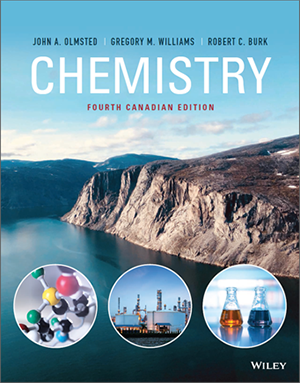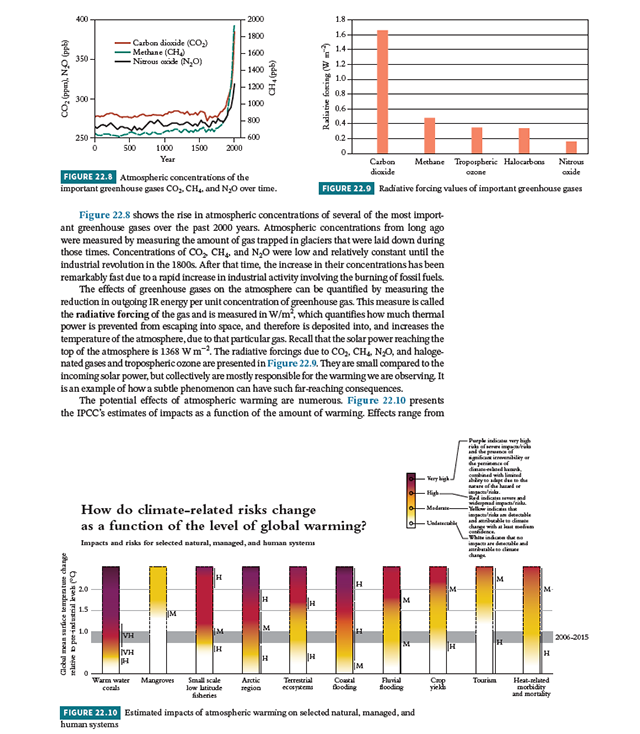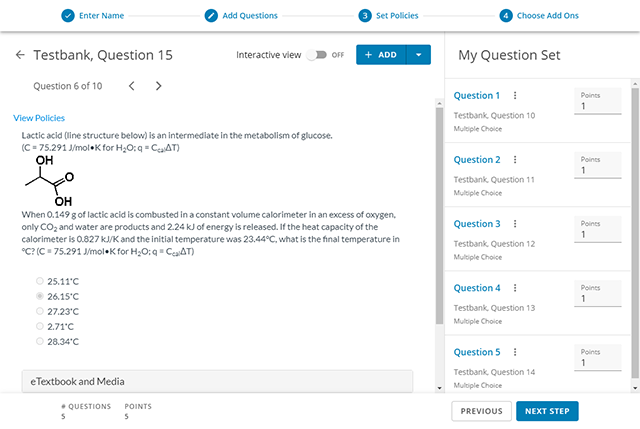
Chemistry, 4th Canadian Edition
By John A. Olmsted, Gregory M. Williams, Robert C. Burk
Chemistry, 4th Edition is an introductory general chemistry text written specifically with Canadian professors and students in mind. A reorganized Table of Contents and inclusion of SI units, IUPAC standards, and Canadian content distinguish this text from other offerings. Designed to engage and motivate today’s Canadian students, this text accurately reflects the curriculum of most Canadian institutions. Chemistry is sufficiently rigorous yet provides an accessible format, clear language, and an effective problem-solving program that avoids an excess of material and redundancy.
Schedule a Demo Request Instructor AccountWant to learn more about WileyPLUS? Click Here
Office Hour Videos:
Over 100 office hour-style videos created by the Canadian author provide additional support for teaching and learning, both in online formats, and as a support for face-to-face instruction.

New Chapter on Environmental Science:
A full chapter on environmental chemistry has been added to the 4th edition, aligning perfectly with topics covered in previous chapters. This allows instructors to focus heavily on the applications of environmental chemistry either as a separate topic, or integrated into previous chapters.

Updated Test Bank:
An improved and revamped WileyPLUS test bank allows instructors and students access to quality digital assessment for various teaching formats.
What’s New
- New Chapter on Environmental Science: A full chapter on environmental chemistry has been added to the 4th edition, aligning perfectly with topics covered in previous chapters. This allows instructors to focus heavily on the applications of environmental chemistry either as a separate topic, or integrated into previous chapters.
- A New WileyPLUS Experience: An enhanced and improved digital experience! Now available in new WileyPLUS, the 4th Canadian Edition offers more instructor control, improved assessment capabilities, better accessibility, and improved ease of use for a better experience for both instructors and students.
- Updates Throughout the Text and WileyPLUS: This edition contains extensive updates, including new chapter openers, updates to chapter 11 (Organic Chemistry: Reactions), and a movement toward 100% IUPAC compliance with the entire text and all problems using SI units.
Additional Features Include
- New Classroom response system (Clicker) PowerPoint slides
- Author-created Lecture PowerPoint slides
- Computerized TestGen Test Bank (MAC and Windows)
- Key Term Glossary Crossword Puzzles
- Major improvements to accessibility throughout student resources following a11y standards
ROBERT C. BURK is an Associate Professor of Chemistry at Carleton University, Ottawa, Canada, where he has been a member of the Carleton Chemistry faculty since 1993. He received his BSc and MSc degrees from Carleton, both involving work in radioanalytical chemistry. Bob worked for six years in the nuclear industry, doing research on the production of nuclear fuels, before returning to Carleton University to earn his PhD in the area of supercritical fluid extraction. His research involves the use of supercritical fluids for separation purposes, as well as development of analytical methods for organics in water using novel solid phase materials such as carbon nanotubes. He is especially interested in the use of technology for teaching chemistry. He was a winner of the 2004 OCUFA teaching award and a 3M teaching fellowship in 2006.
JOHN OLMSTED III is Professor Emeritus of Chemistry at California State University, Fullerton, retiring in 2003 after nearly 40 years of teaching and research in general and experimental physical chemistry. John was honored as the CSUF Outstanding Professor in 1997–98 and served as department chair from 1998 to 2001. In addition to 25 years at CSUF, he taught for 12 years at the American University of Beirut. He had visiting teaching/research appointments at UCLA and the University of North Carolina at Chapel Hill and did research at the Max Planck Institute for Biophysical Chemistry in Göttingen, Germany, the University of California at San Diego, and Sandia National Laboratory in Albuquerque, NM. John received his BS degree in chemistry from Carnegie Institute of Technology and his PhD in physical chemistry from UC Berkeley, where he also did postdoctoral work at the Lawrence Berkeley Laboratory. He has more than 30 refereed research publications and has also published regularly on chemical education topics in the Journal of Chemical Education.
GREG WILLIAMS is Professor of Chemistry at the University of Oregon. He earned an undergraduate degree in chemistry at UCLA and a PhD in inorganic chemistry at Princeton University. He has taught and conducted research at the University of Oregon, California State University, Fullerton, UCLA, and the University of California, Irvine. Outside the classroom, Greg’s professional work focuses on developing e-media for teaching chemistry, including text and interactive graphics and animations.
1 Fundamental Concepts of Chemistry
2 The Behaviour of Gases
3 Energy and Its Conservation
4 Atoms and Light
5 Electronic Structure and Periodic Properties
6 Fundamentals of Chemical Bonding
7 Theories of Chemical Bonding
8 Effects of Intermolecular Forces
9 Properties of Solutions
10 Organic Chemistry—Structure
11 Organic Chemistry—Reactions
12 Spontaneity of Chemical Processes
13 Kinetics: Mechanisms and Rates of Reactions
14 Principles of Chemical Equilibrium
15 Aqueous Acid–Base Equilibria
16 Applications of Aqueous Equilibria
17 Electron Transfer Reactions
18 Macromolecules
19 The Transition Metals
20 The Main Group Elements
21 Nuclear Chemistry and Radiochemistry
22 Environmental Chemistry
APPENDIX A Scientific Notation
APPENDIX B Quantitative Observations
APPENDIX C Ionization Energies and Electron Affinities of the First 36 Elements
APPENDIX D Standard Thermodynamic Functions
APPENDIX E Equilibrium Constants
APPENDIX F Standard Reduction Potentials, E°
APPENDIX G Common Polyatomic Ions
APPENDIX H Atomic Masses of the Elements

